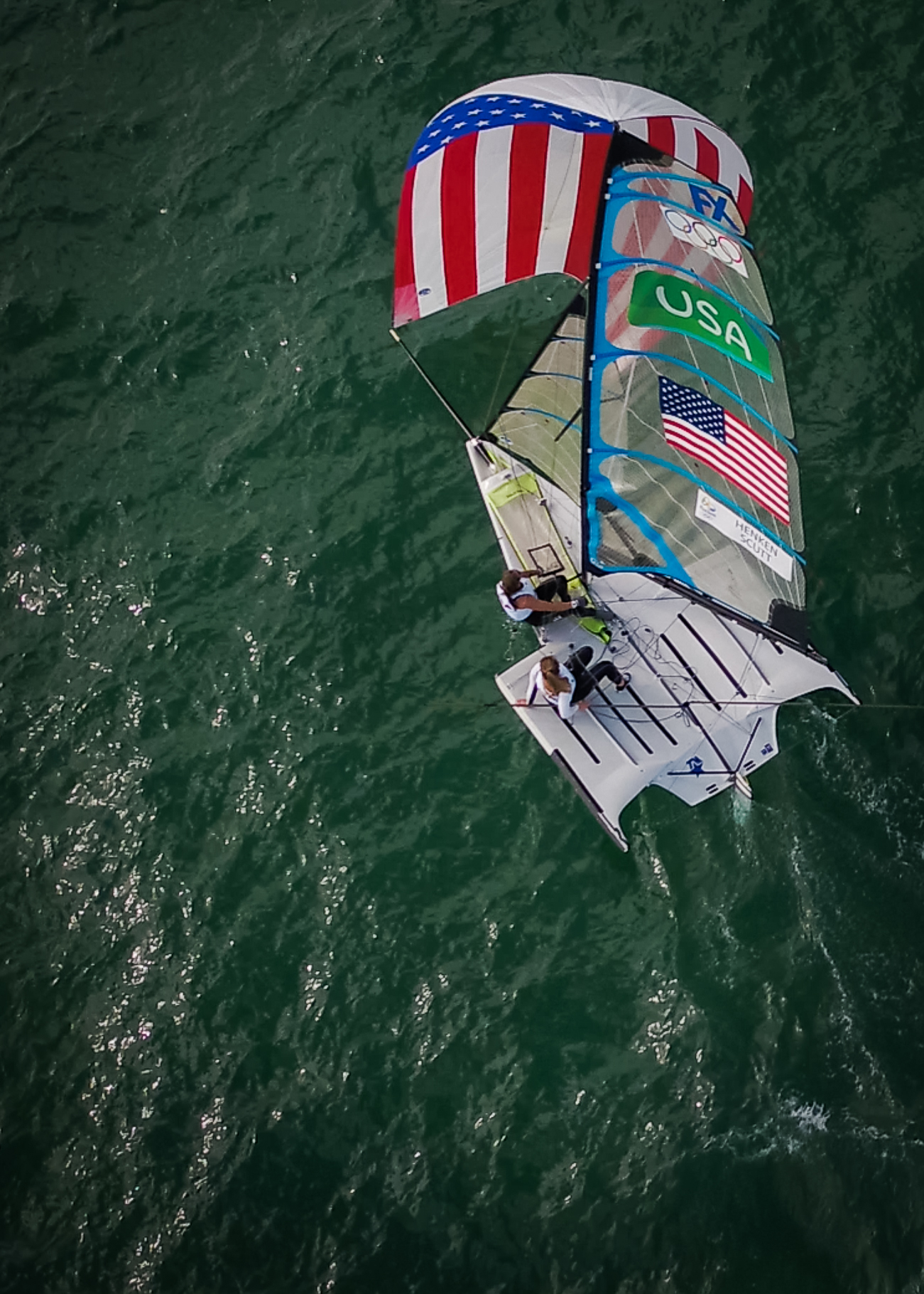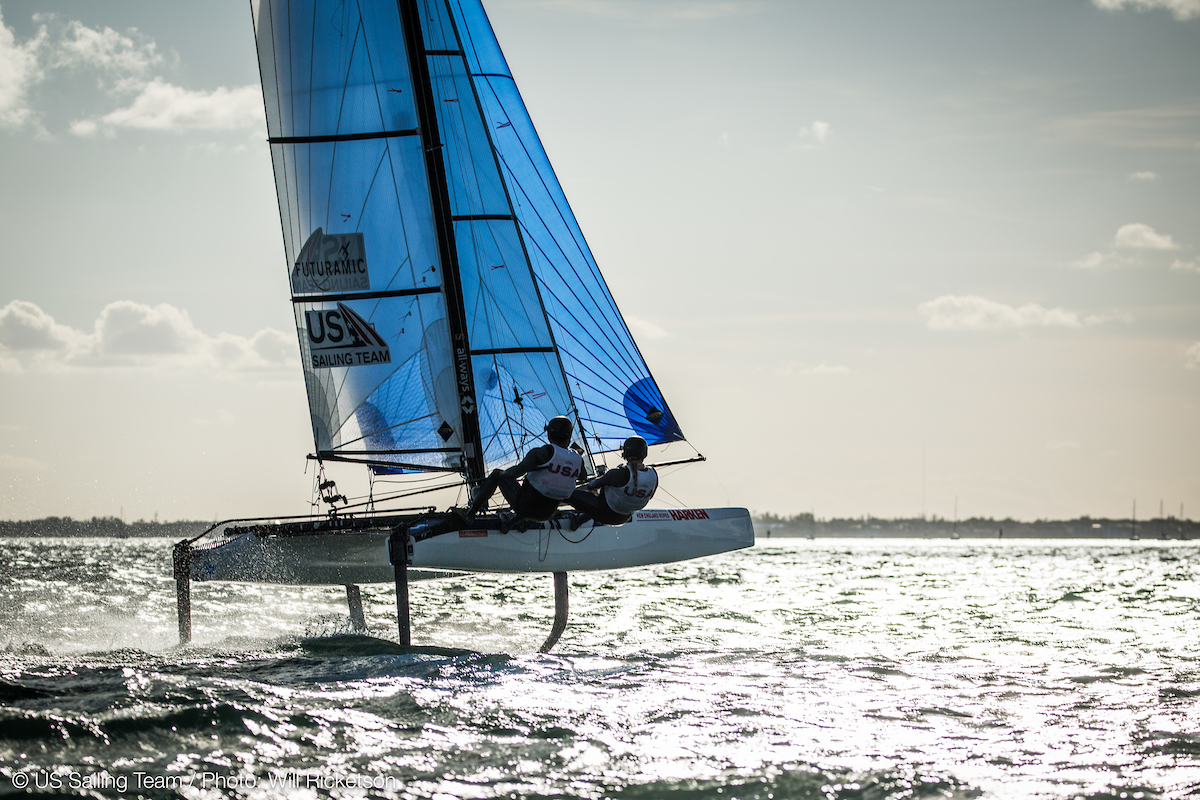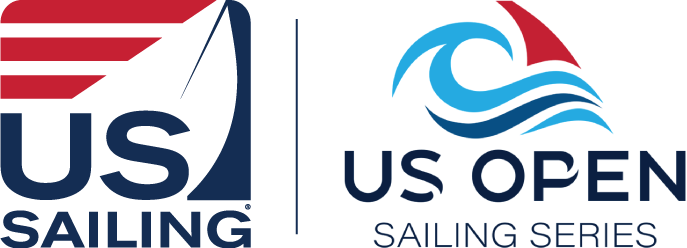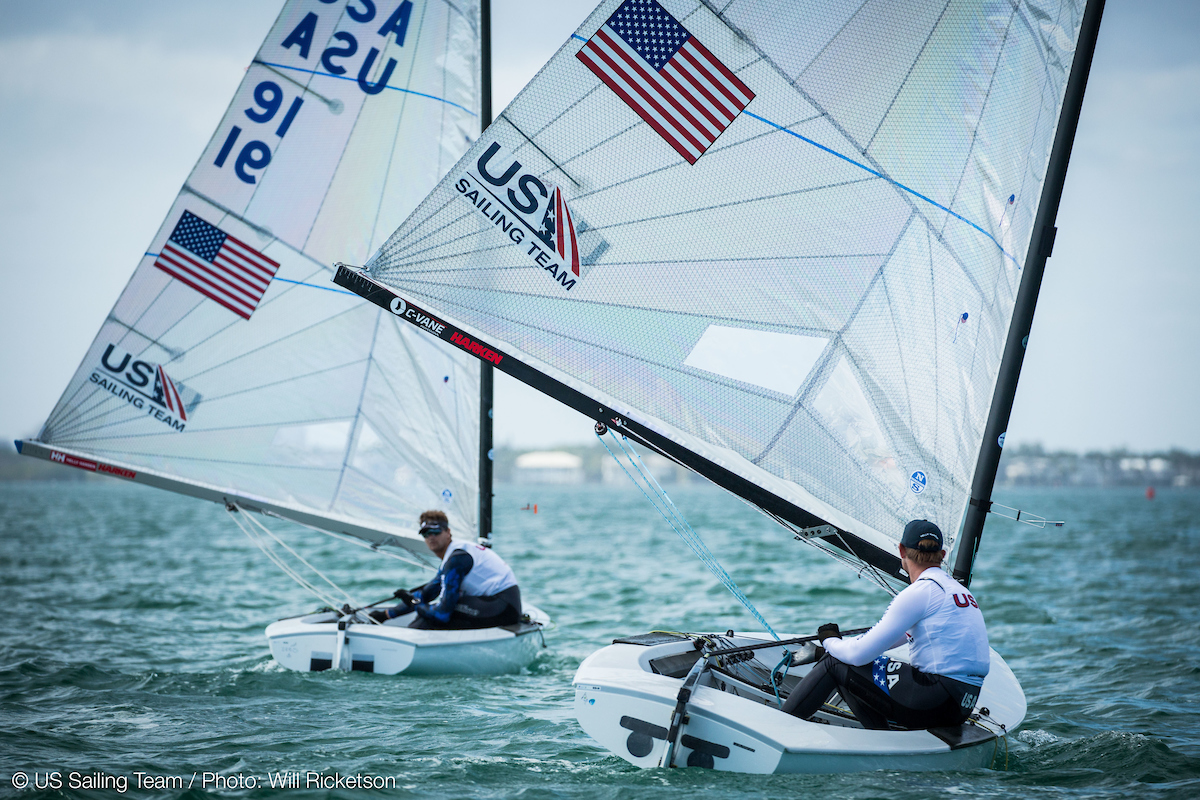Familiar Faces Looking for a Return to Form at 2018 World Cup Series Miami, USA
The sparkling athletic career of Anna Tunnicliffe Tobias, which includes a gold medal in the singlehanded Laser Radial class, a world match racing championship, an appearance au naturel in ESPN the Magazine’s The Body Issue and a transition to an elite-level Crossfit career, bears the hallmarks of someone in full control of her destiny.
But if the next phase is to be successful, Tunnicliffe Tobias (Pittsburgh, Pa.) must come to grips with having someone else at the helm, at least on the race course. After a five-year layoff, she is contemplating a return to Olympic-level sailing, but not as a skipper. This week, she will test out a new partnership by crewing for 2016 Olympian Paris Henken (Coronado, Calif.) in the 49erFX class in the 2018 World Cup Series Miami, USA. Racing starts tomorrow and runs through Sunday, January 28. The Medal Races on Saturday and Sunday will be streamed live to the web and via a Jumbotron in Coconut Grove’s Regatta Park.
 “The transition, it’s harder going to the front of the boat,” says Tunnicliffe Tobias. “I haven’t really ever crewed in a permanent position before so that’s a little different, but what’s fun about the FX is that there’s so much going on at the front. You kind of forget that you’re not driving. There are times when it feels odd, like we’ll be in close quarters and I want to do something. But you know, I trust [Paris], she’s very good at what she does. Coming into it, being able to trust her right away is a pretty good feeling.”
“The transition, it’s harder going to the front of the boat,” says Tunnicliffe Tobias. “I haven’t really ever crewed in a permanent position before so that’s a little different, but what’s fun about the FX is that there’s so much going on at the front. You kind of forget that you’re not driving. There are times when it feels odd, like we’ll be in close quarters and I want to do something. But you know, I trust [Paris], she’s very good at what she does. Coming into it, being able to trust her right away is a pretty good feeling.”
The 49erFX class (right) is one of 10 sailing disciplines that will compete in the Tokyo 2020 Olympic Regatta. Medal contenders in all 10 will be competing at the 2018 World Cup Series Miami, USA, the second stop, of four, on World Sailing’s 2017-’18 World Series Cup tour. Among the more than 540 sailors competing in the 29th edition of this regatta are 27 Olympic medalists.
Henken and Helena Scutt (Kirkland, Wash.) finished 10th in the Rio 2016 Olympic Games—an impressive Olympic debut—but Scutt is now sailing in the coed Nacra 17 class with Bora Gulari. That leaves the 49erFX class without a clear favorite for the lone U.S. berth. Stephanie Roble (East Troy, Wis.), US Sailing’s 2014 Rolex Yachtswoman of the Year, and Maggie Shea (Wilmette, Ill.) have been the most active U.S. team in the early part of this Olympic cycle, earning a bronze at last year’s test event for the 2018 Hempel Sailing World Championships in Aarhus, Denmark, this coming summer. And there are two younger teams competing in Miami this year as well. While this coming week should serve to clarify the pecking order amongst the four teams as well as where the U.S. group stands relative to the rest of the world, Tunnicliffe Tobias, a veteran a numerous Olympic campaigns, knows the importance of not looking too far ahead.
“I think our main goal for the week is to kind of get comfortable racing with each other,” she says. “We’ve got nine days in the boat coming into the regatta, so obviously still have got a huge learning curve to climb and to get more comfortable with boat handling. Then from that, get our heads out so we can race smart. So, we’re gonna go have fun and try to let results take care of themselves.”
For Olympic class sailors, Miami has become something of a home away from home. The combination of an established event with great onshore facilities and South Florida’s reliable mid-winter weather have made this area a popular training destination for sailors from all over the Northern Hemisphere.
“When everywhere else in the world is cold and difficult,” says American Finn sailor Caleb Paine (San Diego, Calif.), who broke an 8-year medal drought for the U.S. Sailing Team with a bronze in the Rio 2016 Olympics. “Miami always brings great conditions, beautiful weather, and world-class competition.”
After winning his bronze medal, Paine took some time away from the Finn dinghy, the oldest of the eight boats that will be used for Olympic competition in 2020. This event will mark his return to top-level competition and his eyes are squarely focused on moving up a step or two on the podium in two years time. Luke Muller (Ft. Pierce. Fla.) has been the top American Finn sailor in Paine’s absence. Muller is still climbing the learning curve, but his progress at this regatta—27th in 2015, 14th in 2016 and fourth last year—hints at his potential.
Muller’s rise up the ranks also highlights another important aspect of this event, the value it has for the US Sailing Team and its Olympic Development Program. While the spotlights are focused at the head of the results table in each class, further down the standings the future of the American sailing is learning the ropes or even just trying Olympic classes on for size. Muller’s experience in this event goes back to 2012, when he competed in the Laser class. Scutt also sailed in this event for the first time while still in college. While she’s since graduated, she still relishes the opportunity to compete on home turf each January.
 “Since the world circuit is very Euro-centric, it’s an asset to have a regatta on home soil because the world comes to you,” says Scutt. “Especially being at the beginning of the season, it means we have a more extended time ‘at home’ than we would otherwise.”
“Since the world circuit is very Euro-centric, it’s an asset to have a regatta on home soil because the world comes to you,” says Scutt. “Especially being at the beginning of the season, it means we have a more extended time ‘at home’ than we would otherwise.”
Scutt and her partner, 2016 Olympian Bora Gulari (Detroit, Mich.), will be sailing the Nacra 17 multihull (at right), which debuted at the 2016 Olympics and has since added lifting foils that allow the boat to often sail with boat hulls clear of the water. The duo was set to sail together at last summer’s class world championship, but an injury to Gulari’s hand forced them to skip that event. Though Gulari has perhaps as much experience as anyone in the world in foiling dinghies—he was an early pioneer in the foiling Moth class and a two-time world champion—this event will be their first chance to really test themselves against the best in the world.
by Stuart Streuli, World Sailing
All photos: © Will Ricketson/US Sailing Team

